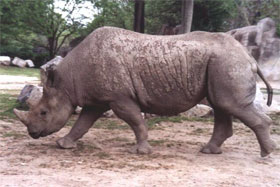Emerging Science Note/Rhinos Rebound
Air Date: Week of July 30, 2004
Living on Earth’s Jennifer Chu reports on efforts to rehabilitate the black rhino.
Transcript
CURWOOD: Just ahead: trying to reap a dividend of peace by bringing a culture and its language back from the brink of extinction. First, this note on emerging science from Jennifer Chu.
[SCIENCE NOTE THEME]
CHU: Efforts like South Africa’s Black and White Rhino Management and Conservation Project are helping to put the almost-extinct black rhino on the road to recovery. The black rhino population dropped to roughly 2,400 in the 1990s from previous estimates of 100,000 in the 1960s. The numbers fell when demand for rhino horn, used for everything from dagger handles to anti-fever medication, caused rampant poaching throughout Africa.

A black rhinocerous (Photo: Courtesy of Harry Foundalis, CRCC, Indiana University)
By keeping the groups small, female rhinos are kept in top breeding condition rather than being forced to compete with other females for food. Scientists hope such efforts will mirror the success of the black rhino’s bigger cousin, the white rhino, the world’s second largest mammal. The white rhino population once dwindled to just fifty a century ago, but today stands at 11,000. That’s this week’s Note on Emerging Science. I’m Jennifer Chu.
CURWOOD: And you’re listening to NPR’s Living on Earth.
ANNOUNCER: Support for NPR comes from NPR stations, and The Noyce Foundation, dedicated to improving math and science instruction from kindergarten through grade 12; Ford, presenting the Escape Hybrid, whose full hybrid technology allows it to run on gas or electric power. Full hybrid technology details at fordvehicles.com; The Annenberg Fund for excellence in communications and education; and, The Kellogg Foundation, helping people help themselves by investing in individuals, their families, and their communities. On the web at w-k-k-f dot org. This is NPR, National Public Radio.
[MUSIC: Orbital “P.E.T.R.O.L.” ? SOUNDTRACK (Thrive – 1998)]
Living on Earth wants to hear from you!
Living on Earth
62 Calef Highway, Suite 212
Lee, NH 03861
Telephone: 617-287-4121
E-mail: comments@loe.org
Newsletter [Click here]
Donate to Living on Earth!
Living on Earth is an independent media program and relies entirely on contributions from listeners and institutions supporting public service. Please donate now to preserve an independent environmental voice.
NewsletterLiving on Earth offers a weekly delivery of the show's rundown to your mailbox. Sign up for our newsletter today!
 Sailors For The Sea: Be the change you want to sea.
Sailors For The Sea: Be the change you want to sea.
 The Grantham Foundation for the Protection of the Environment: Committed to protecting and improving the health of the global environment.
The Grantham Foundation for the Protection of the Environment: Committed to protecting and improving the health of the global environment.
 Contribute to Living on Earth and receive, as our gift to you, an archival print of one of Mark Seth Lender's extraordinary wildlife photographs. Follow the link to see Mark's current collection of photographs.
Contribute to Living on Earth and receive, as our gift to you, an archival print of one of Mark Seth Lender's extraordinary wildlife photographs. Follow the link to see Mark's current collection of photographs.
 Buy a signed copy of Mark Seth Lender's book Smeagull the Seagull & support Living on Earth
Buy a signed copy of Mark Seth Lender's book Smeagull the Seagull & support Living on Earth

